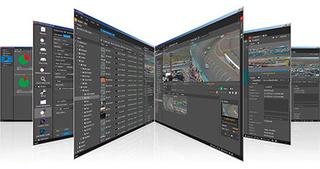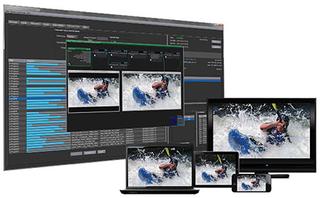Bridging the Digital Content Gap
SAN FRANCISCO—Even with the success that many media and entertainment companies have found in successfully distributing content to more screens, here they sit, facing a similar dilemma: How best to store, manage and deliver content—without putting undue strain on storage and workflow silos—while simultaneously keeping files secure across multiple screens.

Ross Video developed its Inception platform to be the single entry point for content creators—particularly when it comes to handling second-screen programming for social media and web integration.
The way viewers consume content is constantly evolving so it stands to reason that media companies must rely on workflows nimble enough to adapt and evolve through connected, intelligent workflows.
That’s one reason why unraveling digital content management (DCM) in the era of multiple screen delivery is one of the biggest issues facing the industry today.
DCM technologies have come a long way, of course. Who recalls the high-tech process of pawing through racks of labeled tape drives? Today, technologies offer a new means of managing, archiving, distributing and delivering media in a way that offers greater mastery over content.
And now, the priority is to provide for broadcast, social media or the Web. After all, how often these days does breaking news happen at the traditional 6 P.M. timeslot?
“Whether they are writing a story for broadcast, social media or the Web, [users need to be able to] write and publish original content or repurpose content from one platform to another,” said Jenn Jarvis, marketing product manager at Ross Video in Iroquois, Ont.
Get the TV Tech Newsletter
The professional video industry's #1 source for news, trends and product and tech information. Sign up below.
Some DCM solutions are being used in the traditional sense—to produce rundowns, and to connect to MOS workflows with graphics, video servers, teleprompters and other broadcast devices. But newer breeds of systems combine social media and web into the workflow. For some broadcasters, the Ross Inception newsroom computer system is used as a single-entry point for content creators. “If a story is broken on the website first and we want to flip the content into the evening rundown, it only takes a few clicks to reformat the content, all in the same screen,” she said.
Users need to browse traditional newswires in the same screen where they search hashtags on Instagram; as a result, content can be downloaded for reuse in one click, Jarvis said. When paired with the media asset management tool Streamline, users can browse existing assets and add them to on-air graphics or posts for Facebook, Twitter, YouTube or the web.
“When we design a workflow feature, it isn’t about television or digital, it’s about creating a workflow that bridges the gap between the two,” Jarvis said.
FRAGMENTING WORKFLOWS
And still, one of the biggest challenges around multiplatform content creation is the fragmentation of that workflow.
“Every time we add a new platform or output, it often introduces a new content management system or publishing platform,” Jarvis said, with the average content creator embracing about a dozen logins and tools on average for finding information, browsing assets, and creating and publishing content. “If we can combine those platforms into a single portal that can see all the information and push/pull it as needed, we not only make them more efficient but we start to cut down barriers and remove excuses.”

Yet another key priority: finding a solution that simplifies backend processes and cuts down on searches by managing transcodes and uploads in the background.
That is a key component of the Telurio Just In Time Packager from Imagine Communications, a DCM system that packages assets when content is requested by a user, not before, which can potentially save on the need to pre-packaging video-on-demand assets and limit storage costs.
On the output side, when an asset is requested [from] the library, it will be transcoded into the correct format that’s already supported [and has] the packaging wrapper around it that the player needs,” said David Heppe, vice president of OTT product management for Imagine Communications.
The advantage in packaging an asset in the right delivery format at the time it’s requested comes down to storage costs. Without it, “it might be double or triple in storage costs” that you’re forced to accommodate, according to Heppe.
In addition, new DCM solutions are also offsetting operation costs, more effectively repurposing existing content, unifying remote and local facilities via a single search/access system, and better integrating hardware and software technologies. For example, that may mean pulling content directly into a NLE system from storage, and then placing it into a newsroom computer system for rundown management.
That combination is clearly a priority for a broadcaster like NBC Sports, which selected content creation and media management technology from Avid when it set up production for the 2016 Olympic Games in Rio de Janeiro. The priority was to create, manage, distribute and monetize an extraordinary large amount of content, so it was key to find a platform that would allow NBC staffers to collaborate in real time and create and manage content quickly, according to Darryl Jefferson, vice president of Post and Digital Workflow at NBC Sports and Olympics.
“It’s a lot less of a challenge to move media around as files than it is to ship tapes all over the country,” said Matthew Green, senior digital media engineer with the NBC Sports Group. The network uses the technology for coverage of events like NFL football games, NHL hockey games, motor sports, horseracing and golf.
The robustness of the network’s DCM technology was also put to the test at the 2015 Super Bowl in Phoenix, with production split across several cities: NBC Sports’ Stamford Conn. HQ, at the stadium in Glendale, Ariz., and in downtown Phoenix. By using Avid Media Composers and Symphonies on site at the game, the network remotely grabbed edits created back in Stamford and connected them to production in Phoenix.
In previous years, NBC had to lug an entire football season of games from both teams in a truck loaded full of tapes. Now the network’s DCM platform connects to archive and then searches through an asset management system to find a clip, mark edits in and out, and deliver that newly created clip back for airing.
Where we can, we’re trying to stay off physical tape and do more file movement,” Jefferson said. “That has real dollar value to us.”
‘THE NEW CURRENCY’
Another area providing new value for broadcasters: data analytics. This information is proving useful in the daily job of creating, managing and distributing of content.

Imagine's SelenioFlex File
“Broadcast multiplatform environments are all about data analytics; data analytics is the new currency,” said Alex Holtz, director of market development for news and content delivery for Grass Valley. It’s important that broadcasters have tools that allow them to monitor “likes,” monitor shares, determine how news is faring on one platform versus another, and make decisions from there on what to publish, monitor or delete, he said.
“Something could be performing well on Facebook but not as well on Twitter,” he said. “[Understanding] that is part of the solution.”
The company’s newly released Stratus 6.0, which includes a social media management module, gives broadcasters a way to deal with the immediacy of breaking news. “It becomes extremely fast to work on a file, and within seconds be able to publish for breaking stories as they happen, as well as to track and monitor [the story’s] performance and then follow up with new actions,” Holtz said.
This allows broadcasters to expand on events and drive viewers to the right platform.
“Broadcasters not only have to be able to go live at any point in time and not stick to a linear schedule, but they have to be able to expand immediately on trending stories, protect their brand, and get feedback throughout the lifecycle of a story,” Holtz said.
It’s about getting smarter about the constantly delivery of news; the more intelligence you build around data, the better to plan and target content, Holtz said. “Whether it’s based on the time of day or subject matter, producers need to be better enabled [to tell the right stories].”
Susan Ashworth is the former editor of TV Technology. In addition to her work covering the broadcast television industry, she has served as editor of two housing finance magazines and written about topics as varied as education, radio, chess, music and sports. Outside of her life as a writer, she recently served as president of a local nonprofit organization supporting girls in baseball.

